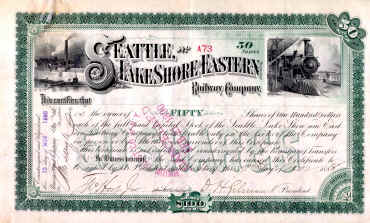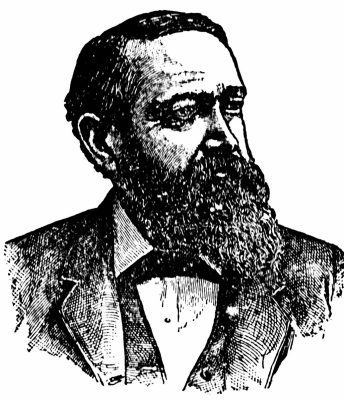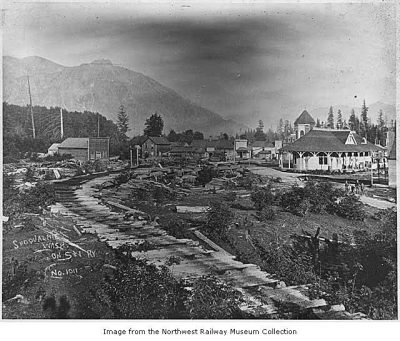Five years ago, we took credit on these pages for Washington State’s 120th birthday. Well, we won’t do that again.
Instead, we’ll take credit for its quasquicentennial!
We said it then and we’ll say it again: it was no coincidence that railroad builder D. H. Gilman signed this Seattle, Lake Shore and Eastern Railway Company stock certificate in 1888, and that U.S. President Benjamin Harrison signed Proclamation 294 admitting Washington into the Union the following year.
 Today, we think the pace of life has rapidly increased with electronics, computers, smartphones — instant this and instant that. And so it has. But that’s just what it felt like as the final decades of the 19th Century hurtled toward the 20th. The railroad turned a laborious multi-day journey from Seattle to Snoqualmie into a picnic. Literally. An excursion to Snoqualmie Falls became a recreational day trip. And folks in Snoqualmie? Whatever they wanted could be brought in by rail. Quickly. Life was transformed. So resist that sleepy historic town stereotype and let the flavor and flourish of those days swirl around you. The Depot and other wood buildings from the period can help you picture it.
Today, we think the pace of life has rapidly increased with electronics, computers, smartphones — instant this and instant that. And so it has. But that’s just what it felt like as the final decades of the 19th Century hurtled toward the 20th. The railroad turned a laborious multi-day journey from Seattle to Snoqualmie into a picnic. Literally. An excursion to Snoqualmie Falls became a recreational day trip. And folks in Snoqualmie? Whatever they wanted could be brought in by rail. Quickly. Life was transformed. So resist that sleepy historic town stereotype and let the flavor and flourish of those days swirl around you. The Depot and other wood buildings from the period can help you picture it.

President Harrison. Courtesy FCIT.
Trains have operated out of the Snoqualmie Depot — the same building — since 1890. The sound of our footfalls may be different without lace-up boots and hard heels. But the creak of the boards would be familiar to those who stepped across the platform and into the ladies’ waiting room to purchase their tickets. Incidentally, lengths of rail currently in front and back of the Depot pre-date the building. So if you step over the track to get to the platform, you may touch the very rail that was here when President Harrison signed that proclamation on November 11, 1889.
What else was here then? The two-story building behind the Depot was built not long after — in 1902 — for the Modern Woodmen’s fraternal organization. Across King Street, the tavern is the original first floor of a two-story hotel built in 1910.
Across the main street from the Depot, at 8096 Railroad Avenue, another wood building harbors stories of Snoqualmie dating from 1909. And not much more than a block away at the corner of River Street and Falls Avenue, the hip roof porch and posts are among the features that maintain the historical appearance of another 1909 building, although additions and changes have been made to the structure since its original construction for Reinig Brothers General Merchandise.
 Is the Snoqualmie of today — a main row of businesses facing the Depot, with additional enterprises peppered around neighboring streets, all in the shadow of Mount Si — so very different from the Snoqualmie shown here in 1897? The Depot-centered activity that greeted Washington’s birth as a state has its echoes in activity surrounding the Depot today. More than 1,000 people rode the train during the last weekend of October. And the Northwest Railway Museum recently launched a steam program. So, when you board the newly rehabilitated coach 218 with its mahogany paneling and mohair-covered seats, you might have an opportunity to ride in the wake of a steam locomotive. Just like the passengers who looked out those coach windows when the State of Washington was just a whippersnapper.
Is the Snoqualmie of today — a main row of businesses facing the Depot, with additional enterprises peppered around neighboring streets, all in the shadow of Mount Si — so very different from the Snoqualmie shown here in 1897? The Depot-centered activity that greeted Washington’s birth as a state has its echoes in activity surrounding the Depot today. More than 1,000 people rode the train during the last weekend of October. And the Northwest Railway Museum recently launched a steam program. So, when you board the newly rehabilitated coach 218 with its mahogany paneling and mohair-covered seats, you might have an opportunity to ride in the wake of a steam locomotive. Just like the passengers who looked out those coach windows when the State of Washington was just a whippersnapper.

